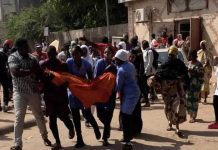Banjul, May 12, 2017 – According to the Integrated Household Survey 2015/16 produced by the Gambia Bureau of Statistics, the proportion of the Gambian population living beneath the national poverty line has remained flat. National poverty increased slightly from 48.1 percent in 2010 to 48.6 percent in 2015. While this increase of the poverty rate was statistically insignificant, the number of poor persons increased substantially by 18.2 percent from 0.79 million in 2010 to 0.94 million in 2015.
There are strong regional and rural urban dimensions of poverty that mask a striking difference, with both very poor and relatively well-off districts found in the same region. Banjul is the least poor while Niamina West is the poorest.
Poverty still remains a rural phenomenon: the poverty rate of the rural areas increased from 64.2 percent in 2010 to 69.5 percent in 2015 – an 8.3 percent increase. The poor in rural areas account for about 64 percent of the total poor in the country. Conversely, urban poverty declined by 5.4 percent from 33.4 percent to 31.6 percent.
Food security is threatening achievement of the poverty eradication. With one rainy season and fertile soils, Gambia has favorable conditions for food production and can produce enough of the main staples to feed its population. Nonetheless, some areas experience significant food insecurity. Estimations based on the IHS 2015/16 suggest that close to 55 percent of the population cannot meet the daily required minimum calories of 2400 per day per person. Brikama is the Local Government Area (LGA) with the largest food insecurity and accounts close to half of the food poor population. Region-level estimates mask the district disparities. The district with largest food poverty is Foni Bintang at 85.5 percent.
Inequality has remained flat. The GINI index is the most commonly used measure of inequality. National GINI stands at 0.359 with inequality higher in urban areas. Brikama, which has the largest number of poor people has the largest inequality. Regional inequality persists and appears to be on the rise.
The results show the positive effects of education in reduction of poverty. In both rural and urban areas, the level of education of the household head is inversely related with the incidence, depth and severity of poverty. People living in a household whose head has no education account for 79.7% of the poor. The incidence of poverty was highest for households with 15 or more members, and declined for households of smaller sizes. Households whose heads are employed in agriculture tend to be poorer and account for 28.2 percent of the population – yet account for 9.9 percent of the population in urban areas and 45.5 percent in rural areas.
What could be driving this rural poverty increase? The overall contribution to GDP growth from agriculture has been declining since 2010. Furthermore, climate related shocks and their effect on agriculture seems to have been a strong driver of food poverty in recent years. Crop production of key items has been showing a declining trend. This has led to a decline in agricultural production and incomes over this decade, making the smallholder farmers vulnerable. With the current population growth rate of about 3.2 per cent per annum, there is need for policies to boost economic growth, and ensure food security to the majority of the population. In addition, high fertility rates may have held back poverty reduction in the country, by increasing the dependency ratio and slowing consumption growth among poor households.
Gambia’s performance on some important non-monetary dimensions of well-being remain low. Access to basic services such as access to electricity for lighting remains limited, educational completion and progression remain low although there has been an increase in the enrolment rates over the last 5 years. Lack of progress in these areas poses a formidable barrier to the country becoming a low middle income. It must be noted however, that Gambia has made significant progress in other human development outcomes, such as child and infant mortality, gender parity index in the last decade.
“The implementation of the Integrated Household Survey series is critical in informing policy makers in particular, by identifying the poor, their location, and their socio-demographic characteristics,” said Nyakassi M.B. Sanyang, Statistician General, GBoS. “Such information is critical in designing policy reforms and programs to boost poverty reduction.”
The current survey comes in very timely. The current survey will form the basis for the formulation of new five-year national development plan (NDP) and marks an important point in future development path for the Gambia. The NDP long-term development vision is to transform the low income country to a competitive low middle income. Reducing the number of people living in poverty will require not only modernizing agricultural production but expanding employment income in non-agricultural sectors. The summary report emphasizes the continued transformative role of agriculture through policy measures that will focus on access of cheaper inputs and extension services available to farmers, alongside affordable credit.
| Gambia Bureau of Statistics, NEWS RELEASE, May 12, 2017 |



















